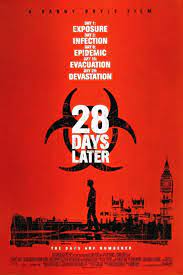
“Rage” is a highly contagious, aggression-inducing virus unleashed in Great Britain after an infected chimpanzee is released by animal liberation activists. Society collapses quickly. 28 days after the outbreak, a bicycle courier named Jim (Cilian Murphy) comes out of a coma in a hospital in London and finds the whole city deserted. He is attacked by the infected but rescued by survivors Selena (Naomie Harris) and Mark (Noah Huntley). Jim asks them to go with him to Deptford, where he learns that his parents have committed suicide. That night, Mark is bitten during an attack and Selena kills him.
Jim and Selena meet cab-driver Frank (Brendan Gleeson) and his daughter Hannah (Megan Burns), who have heard a military broadcast offering safety in Manchester. Frank, Jim, Selena, and Hannah set out in Frank’s cab, but they find the place in Manchester deserted. Frank is infected. Soldiers arrive and kill him.
The two other survivors are brought to a fortified mansion commanded by Major Henry West (Christopher Eccleston). It turns out that the offer of safety was only to find females for sexual slavery and repopulation. Resisting the plan, Jim is targeted by soldiers, but escapes. He lures Major West away, releases Private Mailer (Marvin Campbell)), a chained-up infected soldier, who kills West’s men. Jim brutally kills Corporal Mitchell (Ricci Harvey), an attempted rapist. Jim, Selena, and Hannah try to leave in Frank’s cab, and Major West shoots Jim, but with Hannah’s help, the rabid Mailer kills West, and the survivors drive off.
Another 28 days later, Jim recovers in a cottage in Cumbria. The infected are dying off from starvation. Jim, Selena, and Hannah see a plane go over as they unfurl a banner that says Hello. But three alternative endings on DVD feature Jim dying.
The film was directed by Danny Boyle, written by Alex Garland, and produced by Andrew Macdonald. John Murphy did the music. It received critical acclaim, with praise for Boyle’s direction, Garland’s screenplay, and the creepy atmosphere. Boyle maintained that it was not a zombie film, but it was credited with invigorating the zombie genre, instrumental in replacing slow zombies with fast ones in the movies. It was a financial success and spawned the sequel 28 Weeks Later and at least two comic books. The film was heavily influenced by Day of the Triffids. It was shot mostly in sequence. The disease was based on Ebola, and its major symptom of uncontrollable rage was based on Boyle’s observation that everybody seemed to be angry all the time.
Parts of London were closed off in early morning to film empty streets, and the same was done with highways. When they had to ask impatient drivers to wait while they filmed, they sent out pretty girls, including Danny Boyle’s daughter, to do it, and got a better response. Missing person flyers on walls reminded viewers of those following the 9-11 attacks. The film was made before the attacks but released afterward. Athletes were cast as the infected because of the strange way they could move. The production had permission to destroy Canary Wharf, but forgot to notify the police, who tried to arrest everybody. They also forgot to take away the bodies after a shoot, and a passing motorist crashed upon seeing them and called the police. Many of the scenes reproduced photos that Danny Boyle saw of an earthquake in China, a massacre of Kurds, Pol Pot’s Cambodia, and war in Rwanda, Sierra Leone, and Northern Ireland.
